The Museum Collections
Introduction
I. History and Art Collection
1. Icons of the 14th 19th centuries
icons of the 14th 17th century
2. Jewelry art of the 14th 20th century
jewelry art of the 14th 17th century
jewelry art of the 18th 19th century
the european silver 14th - 19th centuries
3. Small-size sculptures (works of metal, wood, bone)
XI the beginning of the XX century
Small-size sculptures 11th 17th century
Small-size sculptures 18th early 20th century
enamel of Troitza masters 15-8th early 20th century
5.Embroidery, lace, textiles of the 14th - early 20th century
icon and ornamental embroidery
gold and silver lace
6.Painting of the 18th 21st centuries
painting of the 18th 19th centuris
painting of the 20th 21st centuris
II.Manuscripts and old printed books of the 14th 17th century
IV.Lithography of the 18th 19th century
V.Numismatics
VI.Medals of the 18th - early 20th century
VIII.Archeology collection
IX. Russian folk and applied and decorative art of the 17th 21st c.
1. Artistic wood
folk carved and painted wood
wooden toys
house carving of Sergiev Posad
Khokhloma and Gorodets painting
2. Artistic textiles
embroidery and weaving
printed textiles and lace
Russian shawls
folk costumes
folk garments
printed cotton kerchiefs
|
Russian printed cotton kerchiefs of 19th - the beginnings 20th centuries(p. 2)
|
The manufactory of Rubachevs build in 1863 was one more cotton-printing manufacture of Shuya. In the museum collection is 21 gauged Rubachevs kerchiefs which can be divided into four basic groups: black-backdrop with "cucumber" and flower patterns, black-backdrop with a white etching ornament and red calico, presented to a singular.
The group of mourning kerchiefs has been bought in the Tambov region under the name of "silence" or "monk". The originally treated "cucumber", outlined by a smooth contour, made of small colours and vegetative runaways is the basis of their white etching ornament. Both variants alternate with each other on one copy.
ฬanufactories of Bobrov, Gryaznov, Gyubner, Zubkov, Kotov are presented to collections by single items. Several kerchiefs of unknown manufactories dated 1st half 19th centuries allocated from rather big group of ones. They differ, in one case, the friable invoice of a fabric, in other the density thin qualitative calico.
|
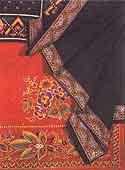
Kerchiefs. Between 1895 and 1910. Vladimir province. Shuya. Factory of Rubachev brothers |
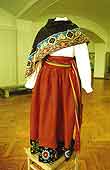
Female celebratory suit, Tambov province. Late20th early 20th centuries |
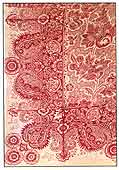
Fragment of kerchief. 19th century. Unknown manufactory |

Indigo kerchief. Late 20th early 20th centuries. Unknown manufactory |
The major phenomena of a public and cultural life of Russia found reflexion and in cotton-printing manufacture. Events of a Patriotic War of 1812, the Manifesto of 1861 on serfdom cancellation, crowning of Russian emperors and empresses, celebrating of the 300 anniversary of a House of Romanovs were especially widely popularised. In museum collection is available a few gauged kerchiefs devoted to Alexander to II Liberator, Nikola II and Aleksandra Fedorovna's coronation, etc.
Ardour of Russian society of the end of 19th century of the Russian history and culture has caused the reference to ornamental riches of past artworks. So, on a border of one kerchief the garland of maple leaves incorporates with fancifully bent curls reminding cut patterns of Velikiy Ustyugs forged boxes of 17th century.
าhus, the collection of cotton-printing kerchiefs of 19th - the beginnings of 20th centuries in our museum disclose features of cotton-printing manufacture of the largest manufactories of Moscow, the Moscow and Vladimir provinces.
|
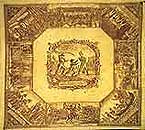
Kerchief. c. 1812. Unknown manufactory |
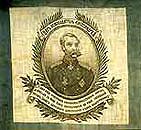
Kerchief. Fragment. Before 1876. Moscow. Danilovskaya manufactory |
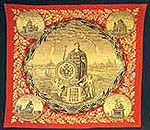
Kerchief. 1896. Moscow. Association of the Danilovskaya manufactory |
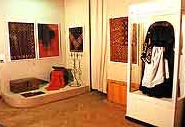
Fragment of the exhibition of Russian print kerchiefs of 19th early 20th centuries. 1994 |
|


